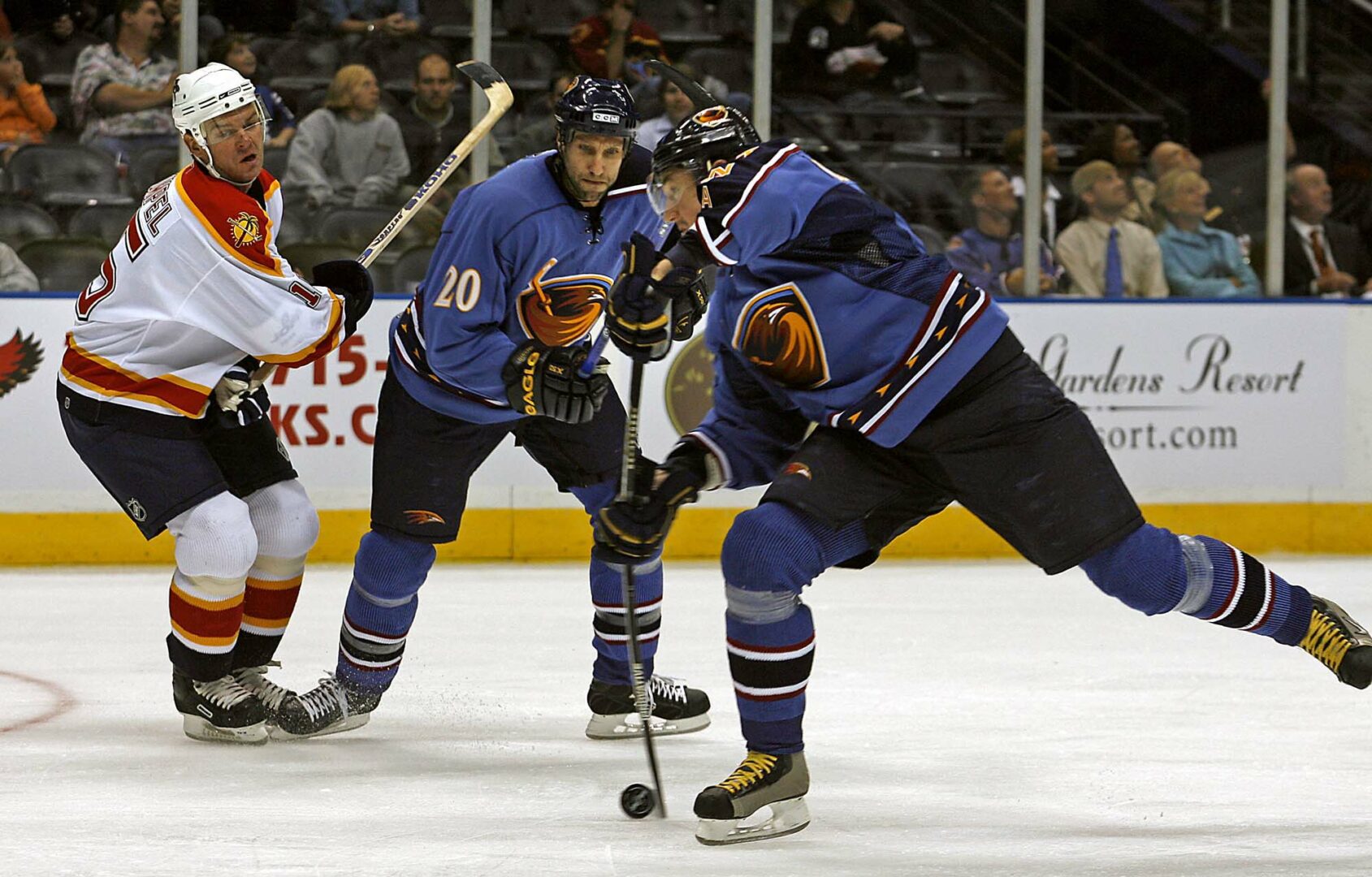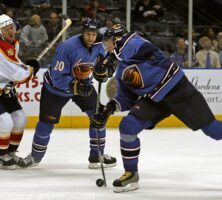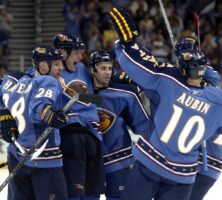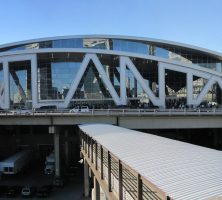The Atlanta Thrashers, a National Hockey League (NHL) franchise, played in Atlanta from 1999 to 2011. In 2011, having lost $130 million since 2005, the team was sold to True North Sports and Entertainment and became the Winnipeg Jets of Manitoba, Canada. Although the team saw little success on the ice, the organization was involved with several successful philanthropic efforts around Atlanta.

Before the arrival of the Thrashers, Atlanta had previously lost two other professional hockey teams. The Atlanta Flames introduced major league ice hockey to the Southeast in 1972, but the team moved in 1980 to Calgary in Alberta, Canada, because of financial problems and low attendance, despite reaching postseason play six times in its eight-year tenure. From 1992 to 1996 the minor league Atlanta Knights of the International Hockey League (IHL) called Atlanta home. The team won the league championship in 1994 but also moved to Canada and eventually disbanded, along with the IHL, in 2001.
Thrashers’ History
In June 1997 the NHL awarded to Atlanta an expansion team slated to begin playing in the 1999-2000 season. That same month Turner Broadcasting System (the team’s original owner, which also owned the Atlanta Braves baseball team and Atlanta Hawks basketball team) announced that the team would be called “the Thrashers” in honor of the brown thrasher, Georgia’s state bird.
A year after the city received its NHL franchise, Don Waddell was hired as the Thrashers’ general manager, and within nine months the team had sold 12,000 season tickets for its inaugural campaign. Season ticket sales declined during the next three seasons but increased for 2003-4.
The first player acquired by the team, in June 1999, was veteran goaltender Damian Rhodes, who played for the Thrashers for three years, despite myriad injuries. In July 1999 Curt Fraser was named the team’s first head coach.
By the time the team played its first home game at the new Philips Arena (later State Farm Arena) in downtown Atlanta on October 2, 1999 (a four-to-one loss to the New Jersey Devils), the NHL had a firm foothold in the South, with teams in central Florida (the Tampa Bay Lightning, established in 1992); Miami, Florida (the Florida Panthers, 1993); Raleigh, North Carolina (the Carolina Hurricanes, 1997); and Nashville, Tennessee (the Nashville Predators, 1998). Although the team showed improvement nearly every season, the Thrashers did not enjoy a winning season or reach the playoffs in its first five years of existence.

In June 2001 the team drafted Ilya Kovalchuk with its first overall pick in the NHL entry draft, making him the first Russian player to be the initial selection in an NHL draft. In 2002 forward Dany Heatley was named the league’s Rookie of the Year, and he and Kovalchuk were named to the All-Rookie Team.
Fraser, who had coached the IHL’s Orlando Solar Bears for four years prior to coming to Atlanta, was fired as head coach in December 2002. General manager Waddell coached the team for its next ten games, and in January 2003 he appointed Bob Hartley, whose Colorado Avalanche team won the NHL’s Stanley Cup in 2001.
Heatley was named the NHL All-Star Game’s most valuable player in 2003. While Heatley had a role in some of the Thrashers’ unforgettable on-ice achievements, he also played a part in what will no doubt remain the team’s most tragic and regrettable incident. On September 29, 2003, he wrecked his sports car in Atlanta’s Buckhead district, killing his teammate and friend Dan Snyder and suffering a broken jaw, concussion, and bruised organs. Heatley, who was charged with second-degree vehicular homicide, received three years probation in 2005 after pleading guilty to four of the six charges leveled against him. He returned to the team to play thirty-one games in the 2003-4 season but was traded to the Ottawa Senators before the start of the 2005-6 season.
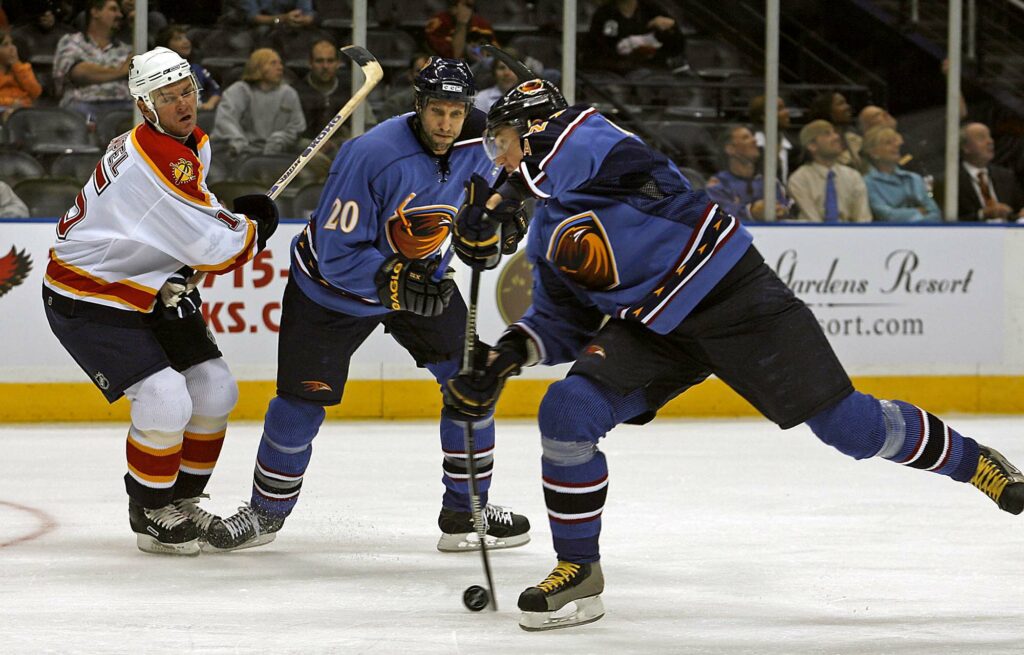
In the winter of 2004 it was announced that Atlanta would host the 2005 All-Star Game, but the game was never played because the league canceled the 2004-5 season due to considerable financial differences between players and team owners. The players’ “work stoppage” lasted more than 300 days but ended in time to stage the 2005-6 season. In March 2004 Time Warner (which had assumed control of Turner Broadcasting) sold the Hawks, the Thrashers, and its operating rights to Philips Arena for $250 million to Atlanta Spirit LLC, which included nine partners operating in Atlanta; Boston, Massachusetts; and Washington, D.C. Veteran sports administrator Bernie Mullin was named president and chief executive officer for both the Thrashers and Hawks.
Center Patrik Stefan, the last remaining original player, was traded to the Dallas Stars before the 2006-7 season. A native of the Czech Republic of Pribram, Stefan was the Thrashers’ first pick and number-one overall selection in the 1999 NHL draft. At the beginning of the 2005-6 season, he was the Thrashers’ all-time leader in games played (350) and in assists (104).
In the 2006-7 season the Thrashers qualified, for the first and only time, for the Stanley Cup playoffs but lost in the first round. In 2007 Hartley was fired; Waddell served as the interim coach until 2008, when John Anderson was hired as the new head coach.
Near the end of the 2009-10 season, Kovalchuk was traded to the New Jersey Devils. More changes were in store for the beginning of the team’s final season in Atlanta, as Rick Dudley assumed the role of general manager, and Craig Ramsey was named the new head coach. The team played its last game on April 10, 2011, losing 5-2 to the Pittsburgh Penguins.
Philanthropy
During its twelve years in Atlanta, the Thrashers organization was extremely active in the community, establishing the “Score for Schools” achievement program and the Thrashers Foundation, which raised funds for nonprofit education and health organizations, as well as for amateur hockey programs. The franchise also created the Junior Authors program, which encouraged young students to write books about ice hockey.
In addition to visiting local children’s hospitals, the team hosted the annual Toys for Tots event with the U.S. Marine Corps and a blood drive with the American Red Cross.





